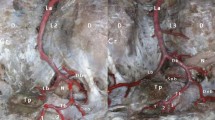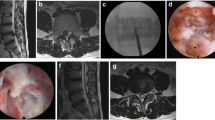Abstract
Full-endoscopic transforaminal lumbar discectomy is based on a puncture technique using a guide needle to reach the target area of the foramen via a percutaneous posterolateral/lateral approach. It may correlate with specific approach-related complications, as exiting nerve root injury. We report the first case of pseudoaneurysm of the lumbar segmental artery secondary to a transforaminal full-endoscopic surgery in the treatment of a lumbar herniated disc. A 39-year-old man underwent left L4-L5 full-endoscopic transforaminal lumbar discectomy for a herniated disc. Three hours after surgery, he experienced acute progressive abdominal pain. An abdomen CT scan showed contrast extravasation in the left paraspinal compartment at L4 vertebral body level. The selective left lumbar angiogram revealed a pseudoaneurysm of a side branch of the left lumbar segmental artery, which was treated by endovascular coiling. The patient made a rapid postoperative recovery without further complications and was discharged 4 days later. This report identifies a rare complication of transforaminal full-endoscopic surgery in the treatment of a herniated lumbar disc. To our knowledge this is the first case of pseudoaneurysm formation of the lumbar artery following a full-endoscopic transforaminal lumbar discectomy.



Similar content being viewed by others
References
Ahn Y (2012) Transforaminal percutaneous endoscopic lumbar discectomy: technical tips to prevent complications. Expert Rev Med Devices 9:361–366
Ahn Y, Kim JK, Lee BH et al (2009) Postoperative retroperitoneal hematoma following transforaminal percutaneous endoscopic lumbar discectomy. J Neurosurg Spine 10:595–602
Birkenmaier C, Komp M, Leu HF, Wegener B, Ruetten S (2013) The current state of endoscopic disc surgery: review of controlled studies comparing full-endoscopic procedures for disc herniations to standard procedures. Pain Physician 16:335–344
Chae KH, Ju CIJ, Lee SM, Kim BW, Kim SY, Kim HS (2009) Strategies for noncontained lumbar disc herniation by an endoscopic approach: transforaminal suprapedicular approach, semi-rigid flexible curved probe, and 3-dimensional reconstruction CT with discogram. J Korean Neurosurg Soc 46:312–316
Choi I, Ahn J-O, So W-S, Lee S-j, Choi I-J, Kim H (2013) Exiting root injury in transforaminal endoscopic discectomy: preoperative image considerations for safety. Eur Spine J 22:2481–2487
Dausse F, Chevallier P, Motamedi JP, Amoretti N, Cua E, Bruneton JN (2006) Lumbar false aneurysms following image-guided interventive procedures for spondylodiskitic abscesses. Skelet Radiol 35:949–952
Fan G, Guan X, Zhang H et al (2015) Significant improvement of puncture accuracy and fluoroscopy reduction in percutaneous transforaminal endoscopic discectomy with novel lumbar location system. Preliminary report of prospective hello study. Medicine (Baltimore) 94:e2189. https://doi.org/10.1097/MD.0000000000002189
Fan G, Gu X, Liu Y et al (2016) Lower learning difficulty and fluoroscopy reduction of transforaminal percutaneous endoscopic lumbar discectomy with an accurate preoperative location method. Pain Physician 19:E1123–E1134
Hsu H-T, Chang S-J, Yang SS, Chai CL (2013) Learning curve of full-endoscopic lumbar discectomy. Eur Spine J 22:727–733
Kim M-J, Lee S-H, Jung E-S et al (2007) Targeted percutaneous transforaminal endoscopic diskectomy in 295 patients: comparison with results of microscopic diskectomy. Surg Neurol 68:623–631
Lewandrowski K-U (2014) “Outside-in” technique, clinical results, and indications with transforaminal lumbar endoscopic surgery: a retrospective study on 220 patients on applied radiographic classification of foraminal spinal stenosis. Int J Spine Surg 1:8. https://doi.org/10.14444/1026
Nellensteijn J, Ostelo R, Bartels R, Peul W, van Royen B, van Tulder M (2010) Transforaminal endoscopic surgery for symptomatic lumbar disc herniations: a systematic review of the literature. Eur Spine J 19:181–204
Puri AS, Colen RR, Reddy AS et al (2011) Lumbar artery pseudoaneurysm after percutaneous vertebroplasty: a unique vascular complication. Report of 2 cases. J Neurosurg Spine 14:296–299
Ruetten S, Komp M, Godolias G (2005) An extreme lateral access for the surgery of lumbar disc herniation inside the spinal canal using the full-endoscopic uniportal transforaminal approach. Technique and prospective results of 463 patients. Spine 30:2570–2578
Ruetten S, Komp M, Merk H, Godolias G (2007) Use of newly developed instruments and endoscopes: full-endoscopic resection of lumbar disc herniations via the interlaminar and lateral transforaminal approach. J Neurosurg Spine 6:521–530
Ruetten S, Komp M, Merk H, Godolias G (2008) Full-endoscopic interlaminar and transforaminal lumbar discectomy versus conventional microsurgical technique: a prospective, randomized, controlled study. Spine 33:931–939
Sairyo K, Matsuura T, Higashino K et al (2014) Surgery related complications in percutaneous endoscopic lumbar discectomy under local anesthesia. J Med Investig 61:264–269
Santillan A, Patsalides A, Gobin YP (2010) Endovascular embolization of iatrogenic lumbar artery pseudoaneurysm following extreme lateral interbody fusion (XLIF). Vasc Endovasc Surg 44:601–603
Siablis D, Panagopoulos C, Karamessini M et al (2003) Delayed diagnosis of a false aneurysm after lumbar arterial injury: treatment with endovascular embolization: a case report. Spine 28:E71–E73
Tsou PM, Yeung AT (2002) Transforaminal endoscopic decompression for radiculopathy secondary to intracanal noncontained lumbar disc herniations: outcome and technique. Spine J 2:41–48
Ying J, Huang K, Zhu M et al (2016) The effect and feasibility study of transforaminal percutaneous endoscopic lumbar discectomy via superior border of inferior pedicle approach for down-migrated intracanal disc herniations. Medicine (Baltimore) 95:e2899. https://doi.org/10.1097/MD.0000000000002899
Author information
Authors and Affiliations
Corresponding author
Ethics declarations
Conflict of interest
The authors declare that they have no conflict of interest.
Ethical approval
All procedures performed in studies involving human participants were in accordance with the ethical standards of the institutional and/or national research committee (San Giovanni Addolorata Ethical Committee) and with the 1964 Helsinki Declaration and its later amendments or comparable ethical standards.
Patient consent
The patient has consented to the submission of the case report for submission to the journal.
Additional information
Comments
Full-endoscopic procedures are advocated for their minimal invasive nature and most proponents claim complication rates close to zero. While potential advantages like less scaring have not yet been properly evaluated, others have attributed problems like approach-related neuropathic pain to the transforaminal endoscopic route.
This interesting case report adds to the discussion of the pros and cons of full-endoscopic disc surgery in comparison with microscopic procedures reminding us of the difference in possible severe complications of lateral endoscopic procedures with blind access to the site of action.
Claudius Thomé
Innsbruck, Austria
Publisher’s note
Springer Nature remains neutral with regard to jurisdictional claims in published maps and institutional affiliations.
This article is part of the Topical Collection on Spine degenerative
Rights and permissions
About this article
Cite this article
Panagiotopoulos, K., Gazzeri, R., Bruni, A. et al. Pseudoaneurysm of a segmental lumbar artery following a full-endoscopic transforaminal lumbar discectomy: a rare approach-related complication. Acta Neurochir 161, 907–910 (2019). https://doi.org/10.1007/s00701-019-03876-7
Received:
Accepted:
Published:
Issue Date:
DOI: https://doi.org/10.1007/s00701-019-03876-7




